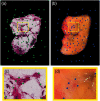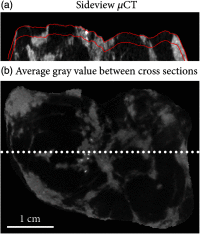Method for coregistration of optical measurements of breast tissue with histopathology: the importance of accounting for tissue deformations
- PMID: 31347338
- PMCID: PMC6995961
- DOI: 10.1117/1.JBO.24.7.075002
Method for coregistration of optical measurements of breast tissue with histopathology: the importance of accounting for tissue deformations
Abstract
For the validation of optical diagnostic technologies, experimental results need to be benchmarked against the gold standard. Currently, the gold standard for tissue characterization is assessment of hematoxylin and eosin (H&E)-stained sections by a pathologist. When processing tissue into H&E sections, the shape of the tissue deforms with respect to the initial shape when it was optically measured. We demonstrate the importance of accounting for these tissue deformations when correlating optical measurement with routinely acquired histopathology. We propose a method to register the tissue in the H&E sections to the optical measurements, which corrects for these tissue deformations. We compare the registered H&E sections to H&E sections that were registered with an algorithm that does not account for tissue deformations by evaluating both the shape and the composition of the tissue and using microcomputer tomography data as an independent measure. The proposed method, which did account for tissue deformations, was more accurate than the method that did not account for tissue deformations. These results emphasize the need for a registration method that accounts for tissue deformations, such as the method presented in this study, which can aid in validating optical techniques for clinical use.
Keywords: diffuse reflectance; gold standard; histopathology; optical techniques; registration algorithm; validation.
Figures








Similar articles
-
Deformable multi-modal image registration for the correlation between optical measurements and histology images.J Biomed Opt. 2024 Jun;29(6):066007. doi: 10.1117/1.JBO.29.6.066007. Epub 2024 Jun 12. J Biomed Opt. 2024. PMID: 38868496 Free PMC article.
-
Method for accurate registration of tissue autofluorescence imaging data with corresponding histology: a means for enhanced tumor margin assessment.J Biomed Opt. 2018 Jan;23(1):1-11. doi: 10.1117/1.JBO.23.1.015001. J Biomed Opt. 2018. PMID: 29297208 Free PMC article.
-
Improving oncoplastic breast tumor bed localization for radiotherapy planning using image registration algorithms.Phys Med Biol. 2018 Jan 31;63(3):035024. doi: 10.1088/1361-6560/aaa4b1. Phys Med Biol. 2018. PMID: 29293469
-
[Computer-aided Prognosis for Breast Cancer Based on Hematoxylin & Eosin Histopathology Image].Sheng Wu Yi Xue Gong Cheng Xue Za Zhi. 2016 Jun;33(3):598-603. Sheng Wu Yi Xue Gong Cheng Xue Za Zhi. 2016. PMID: 29709166 Review. Chinese.
-
The registration of multiple medical images acquired from a single subject: why, how, what next?Stat Methods Med Res. 1997 Sep;6(3):239-65. doi: 10.1177/096228029700600304. Stat Methods Med Res. 1997. PMID: 9339499 Review.
Cited by
-
Point Projection Mapping System for Tracking, Registering, Labeling, and Validating Optical Tissue Measurements.J Imaging. 2024 Jan 30;10(2):37. doi: 10.3390/jimaging10020037. J Imaging. 2024. PMID: 38392085 Free PMC article.
-
Discriminating healthy from tumor tissue in breast lumpectomy specimens using deep learning-based hyperspectral imaging.Biomed Opt Express. 2022 Apr 4;13(5):2581-2604. doi: 10.1364/BOE.455208. eCollection 2022 May 1. Biomed Opt Express. 2022. PMID: 35774331 Free PMC article.
-
Explainable liver tumor delineation in surgical specimens using hyperspectral imaging and deep learning.Biomed Opt Express. 2021 Jun 28;12(7):4510-4529. doi: 10.1364/BOE.432654. eCollection 2021 Jul 1. Biomed Opt Express. 2021. PMID: 34457429 Free PMC article.
-
Deformable multi-modal image registration for the correlation between optical measurements and histology images.J Biomed Opt. 2024 Jun;29(6):066007. doi: 10.1117/1.JBO.29.6.066007. Epub 2024 Jun 12. J Biomed Opt. 2024. PMID: 38868496 Free PMC article.
-
Method for co-registration of high-resolution specimen PET-CT with histopathology to improve insight into radiotracer distributions.EJNMMI Phys. 2024 Oct 14;11(1):85. doi: 10.1186/s40658-024-00681-9. EJNMMI Phys. 2024. PMID: 39400788 Free PMC article.
References
-
- McInnes E., “Artefacts in histopathology,” Comp. Clin. Path. 13, 100–108 (2005).10.1007/s00580-004-0532-4 - DOI

